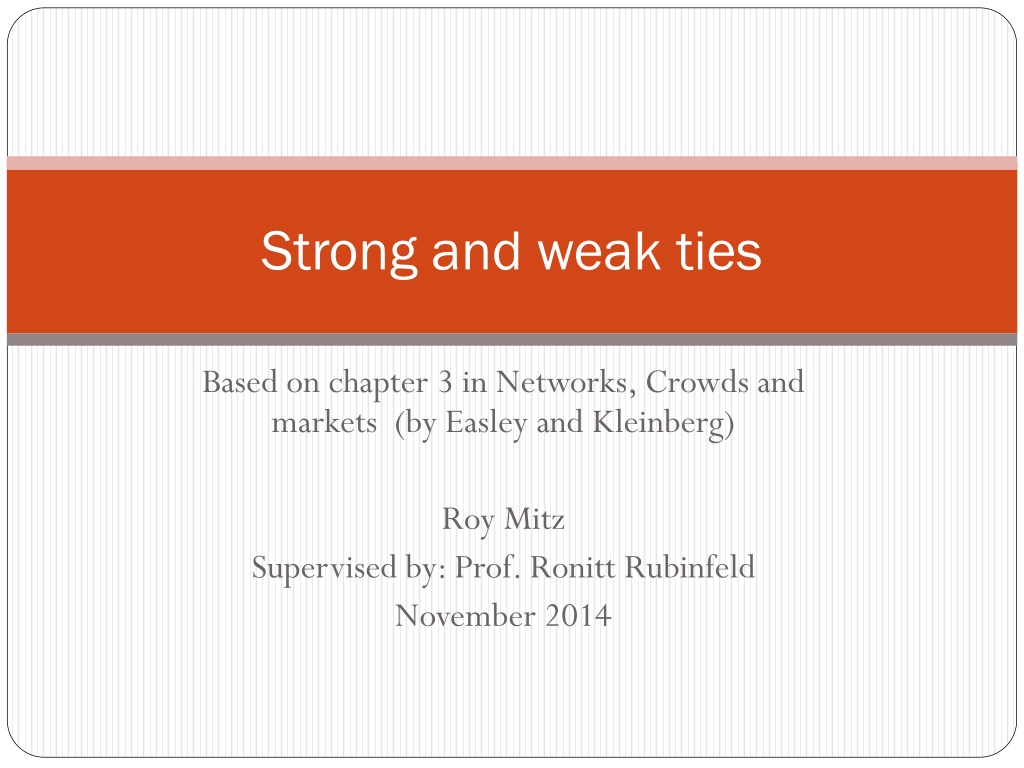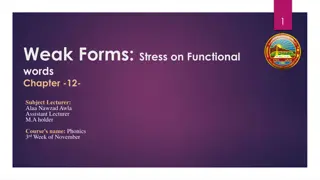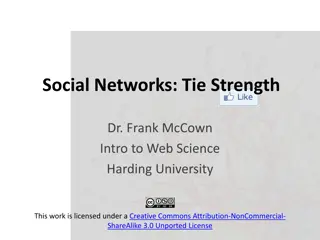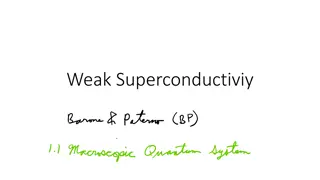Understanding Strong and Weak Ties in Social Networks
Explore the concepts of strong and weak ties in social networks based on Easley and Kleinberg's theories. Delve into the flow of information, structural differences among nodes, and the evolution of networks over time. Discover the significance of triadic closure principle and clustering coefficient in shaping social connections.
Download Presentation

Please find below an Image/Link to download the presentation.
The content on the website is provided AS IS for your information and personal use only. It may not be sold, licensed, or shared on other websites without obtaining consent from the author. Download presentation by click this link. If you encounter any issues during the download, it is possible that the publisher has removed the file from their server.
E N D
Presentation Transcript
Strong and weak ties Based on chapter 3 in Networks, Crowds and markets (by Easley and Kleinberg) Roy Mitz Supervised by: Prof. Ronitt Rubinfeld November 2014
Outline 1. Theory 2. Real data examples 3. Some more structural observations
Preface We will try to discuss the following questions:
Flow of information How information flows through social networks?
Structural difference How different nodes can play structurally distinct roles in this process?
Evolution of a network How these structural considerations shape the evolution of the network itself over time?
Starting point: Strength of weak ties Granovetter, 60 s: Many people learned information leading to their current jobs through personal contacts. Is that surprising?
Starting point: Strength of weak ties These personal contacts were often described by interview subjects as acquaintances rather than close friends Is that surprising?
Triadic closure principle If two people in a social network have a friend in common, then there is an increased likelihood that they will become friends themselves at some point in the future
Evolution and triadic closure Over time we expect to see the formation of such edges
Clustering coefficient The clustering coefficient of a node A is defined as the probability that two randomly selected friends of A are friends with each other.
Motivation for triadic closure Opportunity Basis for trusting Incentive
Bridges and local bridges Structural peculiarity of link to B translates into differences in the role it plays in A s life?
Bridges and local bridges tightly-knit nodes A, C,D, and E exposed to similar opinions /sources of information, A s link to B offers access to new things
Bridges edge e= (A,B) is a bridge if deleting e would cause A and B to lie in two different components.
Bridges and local bridges Real bridges are presumably extremely rare in real social networks.
Local bridges We say that an edge E=(A,B) in a graph is a local bridge if A and B have no friends in common.
Local bridges In other words, if deleting the edge would increase the distance between A and B to a value strictly more than two.
Bridges and local bridges Local bridges provide their endpoints with access to parts of the network, and hence sources of information, that they would otherwise be far away from.
Local bridges vs. triadic closure An edge is a local bridge precisely when it does not form a side of any triangle in the graph
Strength of weak ties revisited We might expect that if a node is going to get truly new information, (e.g., new job leads), it might come unusually often from a friend connected by a local bridge.
Classification of links into strong and weak ties We ll categorize all links in the social network as belonging to one of two types:
Classification of links into strong and weak ties Strong ties (the stronger links, corresponding to friends) Weak ties (the weaker links, corresponding to acquaintances)
Strong Triadic Closure Property Node A violates the Strong Triadic Closure Property if it has strong ties to two other nodes B and C, and there is no edge at all (either a strong or weak tie) between B and C. We say that a node A satisfies the Strong Triadic Closure Property if it does not violate it.
Strong Triadic Closure Property The Strong Triadic Closure Property is too extreme for us to expect it hold across all nodes of a large social network. However, it is a useful step as an abstraction to reality.
Local Bridges and Weak Ties Claim: If a node A in a network satisfies the Strong Triadic Closure Property and is involved in at least two strong ties, then any local bridge it is involved in must be a weak tie.
Local Bridges and Weak Ties Proof:
Local Bridges and Weak Ties In other words, assuming the Strong Triadic Closure Property and a sufficient number of strong ties, the local bridges in a network are necessarily weak ties.
Conclusions in real life 1. The assumptions we made are simplified 2. Making sense as qualitative conclusions that hold in approximate forms
Local bridges in real life Local bridge between nodes A,B tends to be weak tie.
Local bridges in real life Otherwise, triadic closure tends to produce short- cuts to A and B that eliminates its role as a local bridge.
The strength of weak ties Local bridges connect us to new sources of information and new opportunities Local bridges weakness as social ties This dual role as weak connections but also valuable conduits to hard-to-reach parts of the network this is the surprising strength of weak ties.
Cell-phone network (Onnela et al.) A cell-phone provider that covered roughly 20% of the national population The nodes correspond to cell-phone users, and there is an edge joining two nodes if they made phone calls to each other in both directions over an 18-week observation period. Features of a natural social network, such as a giant component.
Generalizing the Notions of Weak Ties The strength of an edge we can make it a numerical quantity, defining it to be the total number of minutes spent on phone calls between the two ends of the edge.
Generalizing the Notions of Local Bridges Neighborhood overlap of an edge connecting we can make it a numerical quantity, defining it to be the total number of minutes spent on phone calls between the two ends of the edge.
Generalizing the Notions of Local Bridges This ratio in question is 0 precisely when the numerator is 0, and hence when the edge is a local bridge.
Empirical result 1 How much it is a local bridge? Strength of a tie
Empirical result 1 How much it is a local bridge? Strength of a tie The weaker the tie is, the more it functions as a local bridge!
Empirical result 2 We saw that weak ties serve to link together different tightly-knit communities that each contain a large number of stronger ties. Can we test that empirically?
Empirical result 2 Starting from removing the strongest edge, edge by edge, the giant component shrank steadily
Empirical result 2 Starting from removing the weakest edge, the giant component shrank more rapidly, and moreover that its remnants broke apart abruptly once a critical number of weak ties had been removed.
Tie Strength on Facebook (Cameron, Marlow et al) All friends: Three categories of links based on usage over a one- month observation period:
Reciprocal (mutual) communication The user both sent messages to the friend at the other end of the link, and also received messages from them during the observation period
one-way communication The user sent one or more messages to the friend at the other end of the link
Maintained relationship The user sent one or more messages to the friend at the other end of the link
Conclusions 1) Even for users who report very large numbers of friends on their profile pages, the number with whom they actually communicate is generally between 10 and 20.























